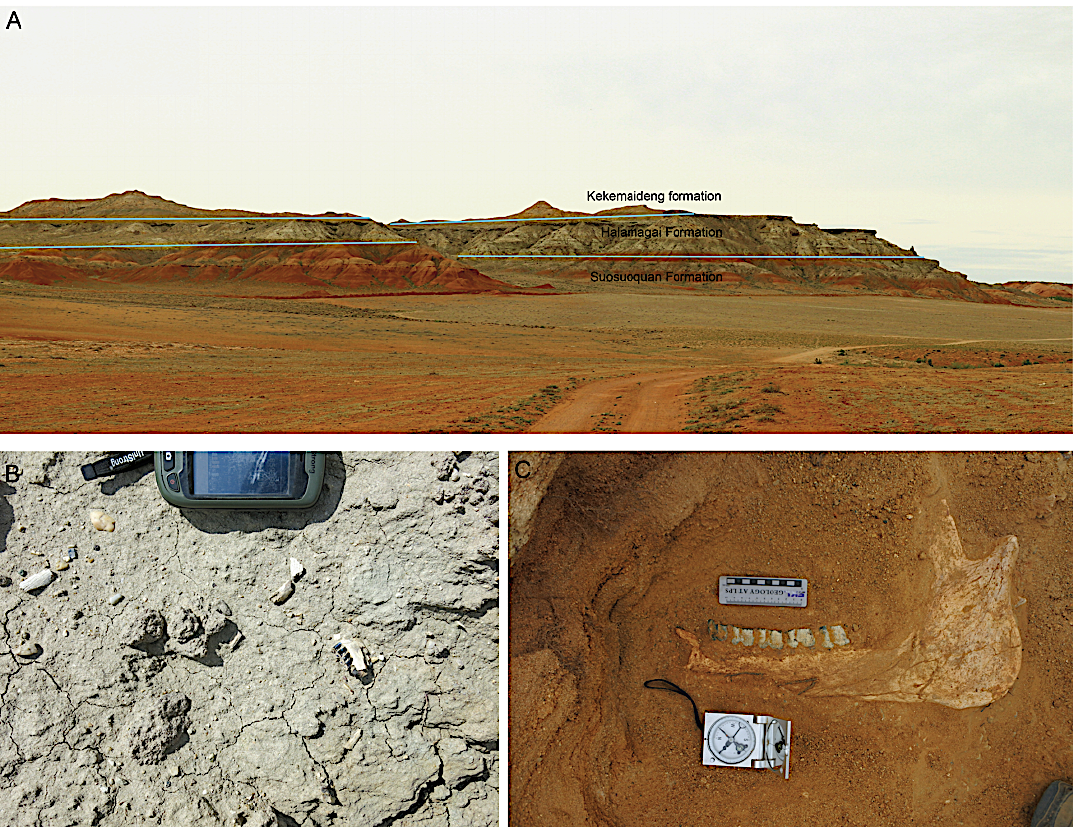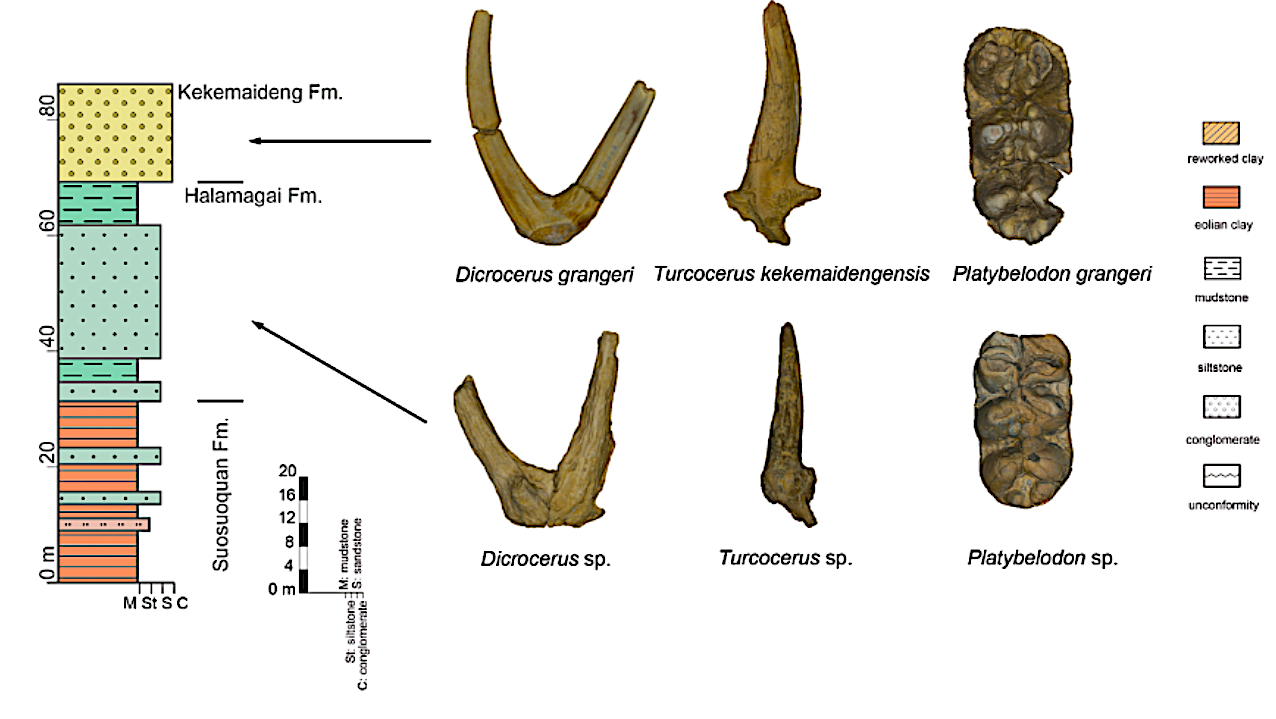Halamagai Fm
Type Locality and Naming
Junggar Basin NW. Named by No. 631 Geological Party of the former Ministry of Geology and Zhu Xia et al. in 1955. The naming section is located in the Duolebulejin Terrace on the south bank of the Ulungur River, Kalamagai Township of the Fuhai County, 65 km south to the Fuhai County. Geographical coordinates: 46°34′10.86″N—87°46′53.1″E(GPS).
[Figure: Geological map of the Duolebulejin Terrace, showing the naming locality of the Halamagai Fm and Kekemaideng Fm]
Lithology and Thickness
Light-gray greenish thick-bedded middle to coarse sandstones and fine-grained gravels, intercalated with thin- to thick-bedded mudstones. Small-scale cross-bedding is common in the sandstones. The Halamagai Formation is 37 m in thickness at the naming section, 26 m at the Tieersihabahe Section (Zhang et al., 2006), 15.5 m at the Chibaerwoyi section (Wang et al., 2019), 25 m at the Dingshanyanchi Section (Sun et al., 2010).
[Figure: Outcrops of the Duolebulejin Terrance. A, Superposition of the Kekemaideng Fm, Halamagai Fm and Suosuoquan Fm; B, Deposits and fossils (Turcocerus sp.) of the Halamagai Fm; C, Deposits and fossils (? Diaceratherium sp.) of the Kekemaideng Fm ]
Relationships and Distribution
Lower contact
Generally, the Halamagai Formation unconformably overlies the Late Oligocene and Early Miocene Suosuoquan Fm, with a hiatus of ~1.5 Myr. However, at the naming locality, the Duolebulejin section, the Suosuoqquan Formation gradually upwardly transforms to the Halamagai Fm, indicating by the greenish standstones that was interbedded in the top strata of the Suosuoquan reddish eolian clasts. Therefore, on the type locality, the two formations are in conformable contact.
Upper contact
In the Duolebulejin section, the Halamagai Fm underlies the yellowish Kekemaideng Fm separated by a thin-layer of brownish ferruginous sandstone, indicating the presence of hiatus. In the other outcrops, the presence of the Kekemaideng Fm is relatively obscure, and if present, they should be conformable contact.
Regional extent
Fuhai, Fuyun Counties, at the Duolebulejin and Tieersihabahe Terrance.
GeoJSON
Fossils
Insectivora: Schizogalerix duolebulejinensis, Mioechinus? cf. gobiensis; Chiroptera: gen. et sp. indet.; Primates: Pliopithecus bii; Lagomorpha: Plicalagus junggarensis, Sinolagomys sp., Alloptox gobiensis; Rodentia: Sinomylagaulus halamagaiensis, Eutamias sp., Atlantoxerus giganteus, A. junggarensis, Palaeosciurus sp., Petauristinae gen. et sp. indet. 1 et 2, Steneofiber depereti, Anchitheriomys tungurensis, Tachyoryctoides sp. nov., Protalactaga grabaui, Protalactaga major, Cricetodon orientalis, Cricetodon sp. nov., Megacricetodon yei, Democricetodon sp., Miodyromys sp., Microdyromys sp., Leptodontomys sp., Sayimys sp. nov., Sicistinae gen. et sp. indet. Carnivora: Pseudaelurus sp., Pseudaelurus cuspidatus, Oriensmilus sp., Tungurictis sp., Tungurictis peignei, ?Thalassicitis chinjiensis, Amphicyon ulungurensis, Cynelos cf. bohemicus, Cynelos aff. Helbingi, Gobicyon zhegalloi, cf. Cynelos sp., Hoplictis baihui, cf. Lartetictis sp. 1, cf. Lartetictis sp. 2, Mustelidae gen. et sp. indet. robust form, Alopecocyon cf. goeriachensis, aff. Stromeriella sp. 1, aff. Stromeriella sp. 2; Proboscidea: Gomphotherium mogoliense, G. connexum, G. steinheimense, Protananucs sp., Platybelodon sp., Choerolophodon sp., Miomastodon cf. tongxinensis, Zygolophodon cf. Turicensis; Perissodactyla: Anchitherium gobiensis, Diaceratherium sp., Aceraterinae indet., Elasmotherinae indet. Artiodactyla: Bunolistriodon sp., Kubanochoerus sp., Elomeryx sp., Blastomerycidae indet., Micromeryx sp., Hispanomeryx sp., Amphimoschus sp., ?Triceromeryx sp., Dicrocerus sp., Stephanocemas aff. thomsoni, ?Lagomeryx cf. complicidens, ?Lagomeryx sp., Ligeromeryx cf. colberti, Ligeromeryx praestans, Ligeromeryx sp., Lagomeryicinae indet., ?Heterocemas sp., cf. ?Cranioceras sp., Giraffoid gen. et sp.nov.1, Giraffoid gen. et sp. nov. 2, Giraffidae (?Canthumerycinae) indet. (large form), Giraffidae indet. (small form), Eotragus halamagaiensis, Turcocerus sp. 1 (large form), Turcocerus sp. 2 (small form), Kubanotragus sp.
[Figure: Stratigraphic column of the Duolebulejin Section, showing the Suosuoquan, Halamagai Fm and Kekemaideng Fm, revealing the morphological evolution of the species with the same genus.]
Age
Depositional setting
Fluvio-lacustrine, primarily channel and over bank facies.
Additional Information


